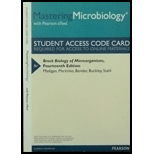
To discuss:
The insertion of transposable elements within a gene can cause mutations. Transposable elements disrupt the continuity of the gene. However, introns also disrupt the continuity of the gene, but the gene can be functional. Why the gene inactivation is caused by only the presence of transposable elements but not introns.
Concept introduction:
Transposable elements are known as stretches of DNA molecules and they can move from one place to another place. Generally, transposable elements are inserted into the other DNA material, for examples, the chromosome, the plasmid, and the viral genome. Transposable elements usually do not contain the origin of replication, therefore, they replicate within the host DNA into which transposable elements are inserted. When the host
Trending nowThis is a popular solution!

Chapter 10 Solutions
Brock Biology of Microorgan. -Access
- The promoter and terminator regions of genes are important in: a. coding for amino acids b. gene regulation c. structural support for the gene d. intron removal e. anticodon recognitionarrow_forwardPortions of eukaryotic mRNA sequence that are removed during RNA processing are . a. exons b. caps c. poly-A tails d. intronsarrow_forwardIn the gene-coding sequence shown here, which of the following events will produce a frameshift after the last mutational site? a. insertion of an A after the first codon b. deletion of the second codon (AAA) c. insertion of TA after the second codon and deletion of CG in the fourth codon d. deletion of AC in the third codonarrow_forward
- Eukaryotic mRNA: usessnRNPs to cut out introns and seal together translatableexons. uses a spliceosome mechanism made of DNA to recognizeconsensus sequences to cut and splice. has a guanine cap on its 39 end and a poly(A) tail on its 59 end. is composed of adenine, thymine, guanine, and cytosine. codes the guanine cap and poly(A) tail from the DNAtemplate.arrow_forward_______ are removed from new mRNAs. a. Introns c. Poly-A tails b. Exons d. Amino acidsarrow_forwardCloning Genes Is a Multistep Process The following DNA sequence contains a six-base sequence that is a recognition and cutting site for a restriction enzyme. What is this sequence? Which enzyme will cut this sequence? (See Figure 13.5 for help.) 5 CCGAGGAAGCTTAC 3 3 GGCTCCTTCGAATG 5arrow_forward
- Exon duplication of multiple alpha-helix coding domains is thought to be responsible for the origin of which vertebrate gene (coding for what is now the most abundant protein in human blood)? the plasminogen gene the albumin gene the urokinase gene the opsin gene the collagen genearrow_forwardWhich of the following mutations is most likely to cause a single amino acid difference during the translation of mRNA into protein? A. Single base-pair insertion B. Single base-pair deletion C. Mutations in regulatory sites D. Base-pair substitutionarrow_forwardWhich of the following mutations would likely have the greatest negative impact on the protein product of a gene? Group of answer choices a single base deletion close to the end of the coding region of a gene a single base insertion just after the start of the coding region of the gene a deletion of three bases near the middle of the gene a base-pair substitutionarrow_forward
- Which of the following mutations would be most likely to have the most negative effect on the functioning of a protein produced by the gene? Group of answer choices a deletion of one nucleotide at the beginning of the coding sequence a substitution of one nucleotide at the beginning of the coding sequence an insertion of three nucleotides near the end of the coding sequence a substitution of one nucleotide near the end of the coding sequencearrow_forwardWhich of the following mutations would be most likely to havea harmful effect on an organism?(A) a deletion of three nucleotides near the middle of a gene(B) a single nucleotide deletion in the middle of an intron(C) a single nucleotide deletion near the end of the codingsequence(D) a single nucleotide insertion downstream of, and close to,the start of the coding sequencearrow_forwardIntrons are: Considered "non-coding" regions Located in the promoter regions of genes Found in prokaryotes A and B A, B, and Carrow_forward
 Human Heredity: Principles and Issues (MindTap Co...BiologyISBN:9781305251052Author:Michael CummingsPublisher:Cengage Learning
Human Heredity: Principles and Issues (MindTap Co...BiologyISBN:9781305251052Author:Michael CummingsPublisher:Cengage Learning Biology: The Dynamic Science (MindTap Course List)BiologyISBN:9781305389892Author:Peter J. Russell, Paul E. Hertz, Beverly McMillanPublisher:Cengage Learning
Biology: The Dynamic Science (MindTap Course List)BiologyISBN:9781305389892Author:Peter J. Russell, Paul E. Hertz, Beverly McMillanPublisher:Cengage Learning Concepts of BiologyBiologyISBN:9781938168116Author:Samantha Fowler, Rebecca Roush, James WisePublisher:OpenStax College
Concepts of BiologyBiologyISBN:9781938168116Author:Samantha Fowler, Rebecca Roush, James WisePublisher:OpenStax College BiochemistryBiochemistryISBN:9781305577206Author:Reginald H. Garrett, Charles M. GrishamPublisher:Cengage Learning
BiochemistryBiochemistryISBN:9781305577206Author:Reginald H. Garrett, Charles M. GrishamPublisher:Cengage Learning




